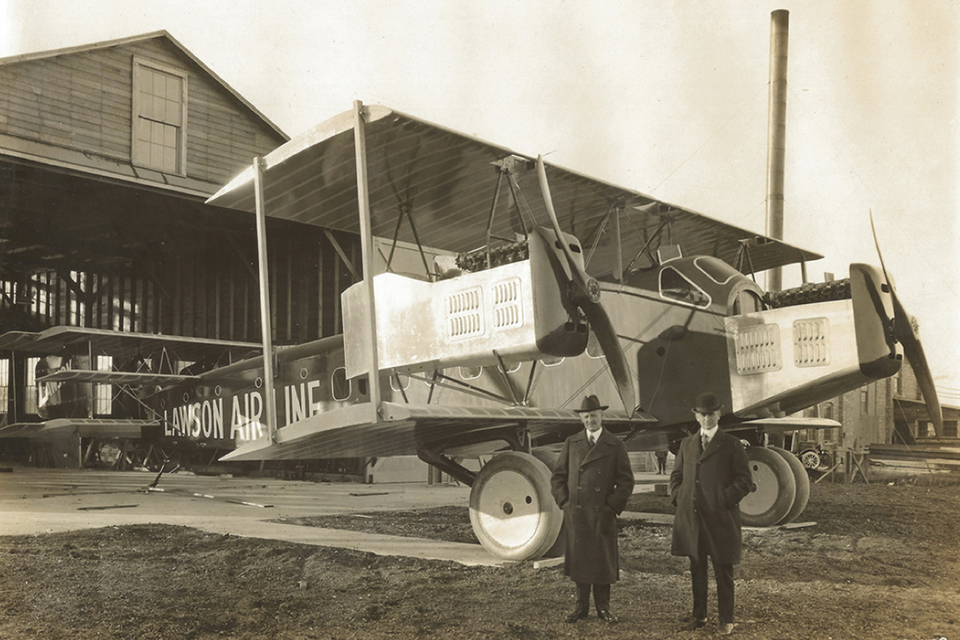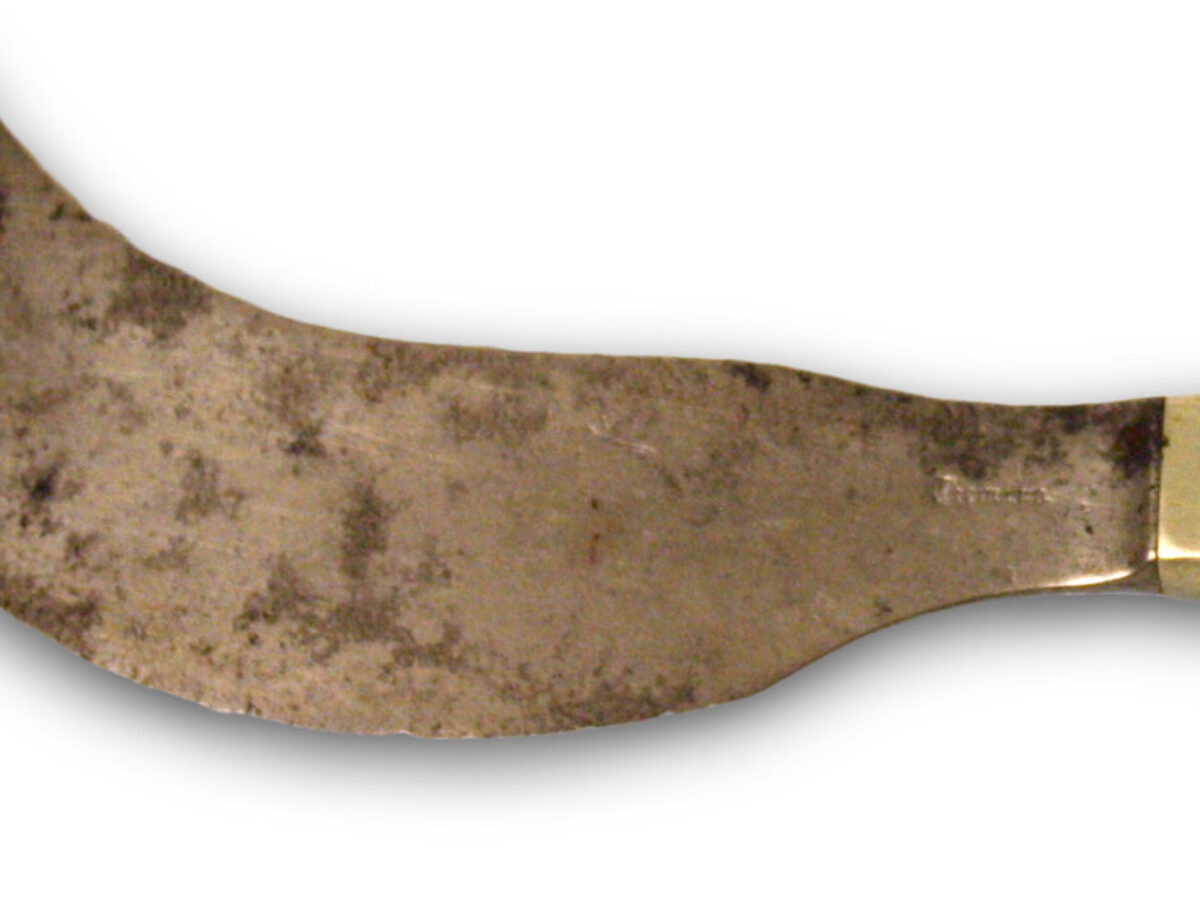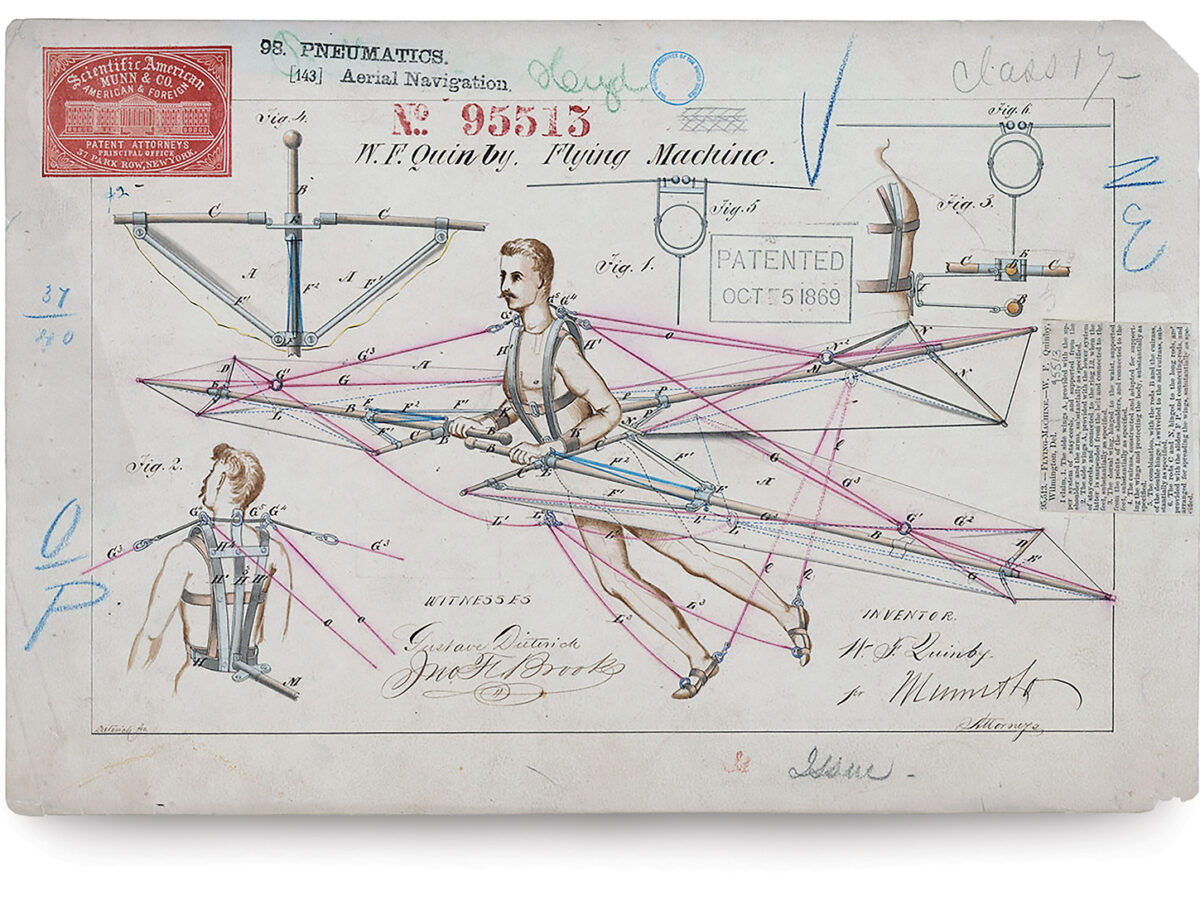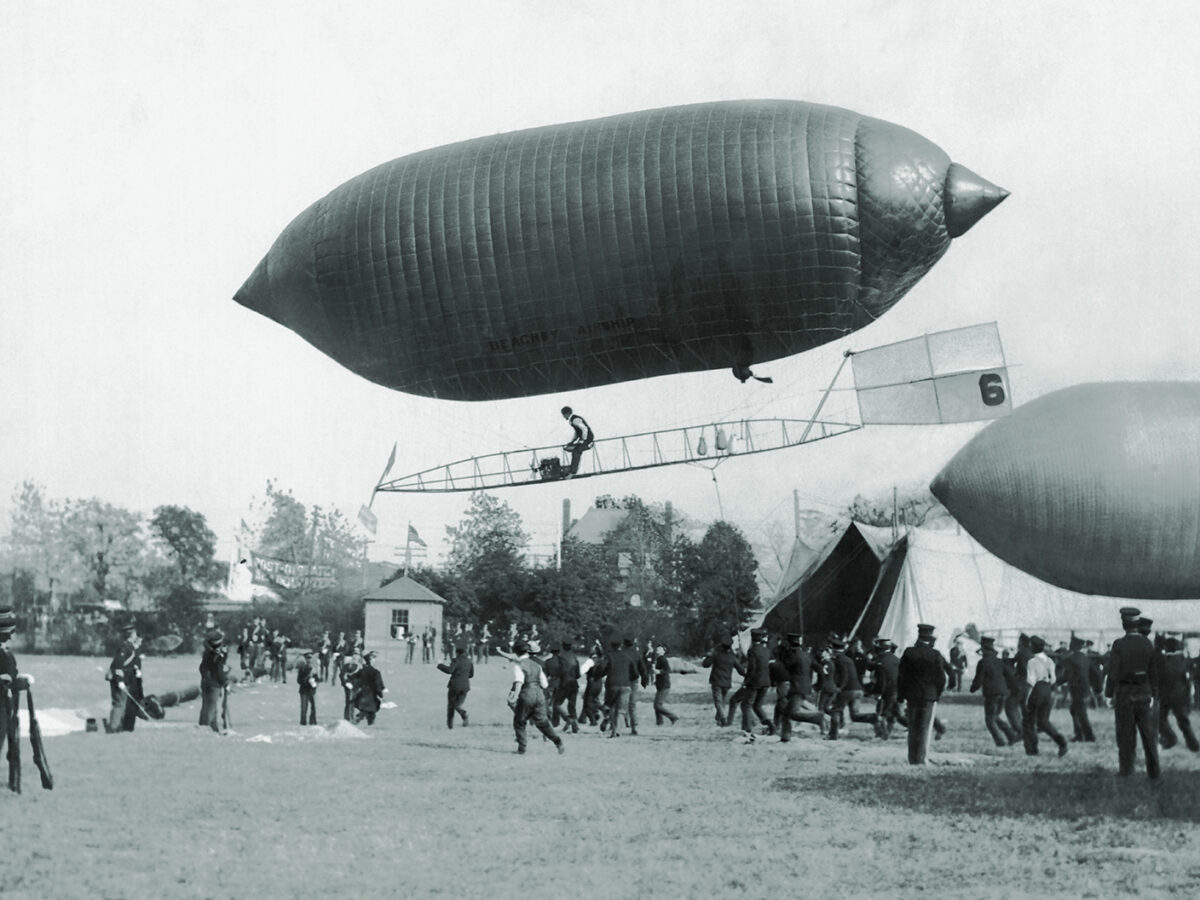You won’t find Alfred William Lawson mentioned in many history books, but he was an early aviation visionary who claimed several firsts. One was that he was the first to use the word “aircraft,” in 1908. He trademarked that word Fly, a magazine he founded in by changing the magazine’s title to Aircraft when he received his first flight instruction in 1910. He also edited a glossary of aviation terms in the 1912 Webster’s Dictionary and helped establish early proficiency standards for pilots.
Born in London, England, in 1869, Lawson immigrated to the United States via Canada to begin school. Full of nervous energy and self-confidence, he quit in the sixth grade when he found himself far ahead of his classmates in the three Rs. He saw no reason to continue with a formal education.
He set out in life on his own, selling newspapers and shining shoes. At age 19, he played baseball for a Goshen, Ind., team. He would later claim in his autobiography that he had invented night baseball in Reading, Pa., in 1907—using a lighting system he himself had designed.
Lawson claimed the ability to foresee the future of aviation and also developed a spiel about a “base of absolute knowledge” that he called Lawsonomy. His slogan was “If it isn’t truth, it isn’t Lawsonomy.” Lawson’s Law of Penetrability was his theory that an object of greater density causes pressure while an object of lesser density causes suction. As a result, everything in space was spinning around in a phenomenon he called Zig-Zag-and Swirl. His Lawsonian principles were as puzzling as much of his life would eventually become.
GET HISTORY’S GREATEST TALES—RIGHT IN YOUR INBOX
Subscribe to our HistoryNet Now! newsletter for the best of the past, delivered every Monday and Thursday.
Air Head
Lawson helped organize air meets in 1910 and 1911, and as a vice president of the Aeronautical Manufacturers Association, boldly sent a message to Congress in 1912 urging a $10 million appropriation to develop American aviation, then ranked lowest in the world for aeronautical expenditures. In 1913 he bought a Thomas Flying Boat and became one of the first air commuters by flying it with a “mechanician” from his home at Seidler’s Beach, N.J., to a dock on the Hudson River near his office in New York City.
Lawson’s early aviation contacts as a publisher led him to locate in Green Bay, Wis., where he found backers to bankroll the Lawson Aircraft Co. in 1917, as the United States entered World War I. Though he was not a trained aircraft designer, his charismatic personality attracted skilled men who could turn his dreams into hardware. He was fond of saying, “I sketch out on the blackboard what I want done, and the men do the rest.”
The company’s first aircraft was the Military Tractor One (M.T.1), a primary trainer biplane intended for the U.S. Army Air Service. Only one of that type was produced, but it was followed in 1918 by the improved M.T.2, for which he received a contract to produce 100. The Army, however, withdrew the contract when the war ended.
Meanwhile, Lawson had proposed the idea of “transoceanic floats,” floating refueling stations that could be spaced across the Atlantic to permit aircraft to be flown to the European theater of operations. Aircraft with wheeled landing gear would land on board, while seaplanes could be serviced alongside. Military leaders considered the idea uneconomical, although the U.S. Navy did adopt the basic principle when a line of destroyers was stationed at 50-mile intervals across the Atlantic to service four Navy Curtiss NC flying boats for a planned transatlantic flight in 1919.
Recommended for you
Thinking up the First Airline
When WWI ended, Lawson decided that aviation had a bright future in peacetime. He visualized a large commercial aircraft to transport passengers on a regular schedule between major cities. He was rebuffed by New York financiers, but found a wealthy backer in Milwaukee and enlisted a brilliant team that included six engineering specialists and aeronautical engineer Vincent J. Burnelli, then 26, later noted for his wide fuselage and lifting body designs. Within five months, the team turned out the first multiengine passenger aircraft ever produced in the United States. It hadn’t been an easy task, as Burnelli described in a 1962 magazine article:
We encountered constant problems. For one thing, the only big planes that had ever been built were bombers. Their interiors were laced with wires and braces to support the shell of the fuselage. Inasmuch as our plane was being designed to carry people, we had to take out all those wires. Using a streetcar as a model, our skilled woodworkers developed laminated wood bulkheads to eliminate cross-bracing. When we got through, you could walk erect in the fuselage of an airplane for the first time.
For the first time, too, a pilot could fly through a blizzard without getting wet and cold. Up until then planes were of open-cockpit design. My plan to enclose the crew with a roof and a Flexiglass front panel was much criticized, even though we placed a small window on the co-pilot’s side so that he could stick his head out into the sleet if he wanted to. It was to be another 10 years before the military adopted planes with enclosed cockpits.
The Lawson C-2
The biplane was designated the Lawson C-2. With a wingspan of 91 feet and a length of 48 feet, its gross weight was 12,000 pounds. The landing gear had two pairs of wheels mounted in tandem under the front section of the plane and a large skid under the tail assembly. Two 400-hp 12-cylinder Liberty engines, mounted between the wings, gave it a cruising speed of 110 mph and a range of more than 400 miles. There were 18 passenger seats, with eight additional folding seats in the passenger compartment.
Lawson had his own ideas about how a flight should be conducted. He called himself “Captain in Command” and handled only the throttles. He employed young Charles L. Cox, a former Royal Air Force pilot, as “steersman” to operate the controls and maneuver the plane as he directed. Cox had only about eight hours’ previous flying time in a large plane when he went to work for Lawson, although Lawson didn’t know that until much later.
The First Flight
Lawson announced to the press that he would make a short test flight around Milwaukee on August 28, 1919. He invited Burnelli and two mechanics to go along. “Lawson waved to the crowd and shoved the throttles all the way forward,” Burnelli explained. “He didn’t even bother to warm up the engines; the founder of Lawsonomy didn’t know his zag from his swirl when it came to minor details like getting oil hot. The plane picked up speed and the solid bank of trees at the end of the runway began getting closer faster. ‘Steer for those trees,’ Lawson ordered, ‘and clear them by fifty feet.’”
Cox complied—barely—and they flew serenely around the area without any difficulty. Lawson ordered Cox to return to the field when they began getting short of fuel, but no one on board had ever seen the city from the air before, and nothing looked familiar. When it became clear that they didn’t know how to find the field, Lawson ordered Cox to land in a cow pasture he had sighted.
The young co-pilot maneuvered bravely toward the landing spot as Lawson cut the throttles. Cox made a very firm power-off landing on the rough field. The only problem was that all four tires blew apart and had to be replaced. When the plane was again ready, Lawson announced that they were going to make a second local test flight, but after takeoff he suddenly ordered Cox to follow the shoreline of Lake Michigan to Chicago, where they landed at Ashburn Field. A large crowd had gathered there because Lawson had alerted the newspapers beforehand. He used the opportunity to announce that he planned to start a 100-plane airline linking New York and San Francisco through Chicago, on a 36-hour schedule. Passengers would be charged according to their weight.
The plane already had the words “LAWSON AIR LINE” painted in large letters on the fuselage, but the announcement came as a surprise to Burnelli and the other designers. “For one thing,” Burnelli later recalled, “we had planned on having several test flights; you just don’t built a plane from scratch in six months without encountering a bug here and there. For another, none of us had brought even so much as a toothbrush. Actually, however, we were all too excited and enthused to really care much where we went, although I doubt if I could say the same for our creditors in Milwaukee.”
Fly East, Young Man
Three days later, Lawson directed Cox to fly eastward with two local fliers and three Chicago newspaper reporters on board. Lawson announced the next stop was Toledo, Ohio. Cox was forced to land in an open field when the park they had intended to land on was full of debris from a prizefight the night before.
The next day, at a luncheon with the Toledo Chamber of Commerce, Lawson expounded on his plans for financing the airline and was cheered by the audience for his bold outlook. With the writers still aboard, Lawson, his crew and passengers then flew to Cleveland to land at the airfield adjoining the Glenn L. Martin factory, where they met Martin, factory manager Lawrence Bell and chief engineer Donald Douglas.
Encouraged by increasingly favorable press about the flight, Lawson decided to head east to Buffalo and then Syracuse—where fate intervened. A stiff wind was blowing across the cabbage field Lawson selected as a landing spot nearest the city, and Cox couldn’t handle the turbulence near the ground. One wingtip slammed into the earth on their approach, and the plane spun around, stopped and tilted up on its nose at a 45-degree angle. Fortunately no one was injured. Repairs ended up taking a week because of a lack of tools and materials.
Lawson had planned to fly to Albany to pick up Governor Alfred E. Smith and take him with great fanfare to New York. Just before takeoff from Syracuse, he received a telegram from the governor with regrets. Burnelli later commented, “News of our cabbage-shredding landing had probably reached him.”
Their next destination was changed to Mitchel Field on Long Island, and on September 13, Lawson and crew, with four new passengers, landed after a record time of two hours, 43 minutes for the 313-mile flight. New York newspapers gave it front-page coverage. The New York Sun used large type to proclaim “Big Aero Pullman Rides Like a Feather No Jolts Nor Worries Start and Landing Fail to Disturb Passengers, Who Marvel at Trip.”
As soon as they landed, Lawson audaciously told the crowd, “In the spring of 1920 the business man of New York will be able to step into an airline sleeper in New York and wake up in Omaha, Neb., the next morning.” Burnelli later recalled that “the New York front pages were full of us. The projected Lawson Air Line had become transcontinental and Lawson was without peer as a leader of aviation.”
Taking It to DC
Lawson was anxious to fly to Washington next to further publicize his plans. He arrived at the capital’s Bolling Field with 10 passengers and a crew of four on September 19 after a four-hour, 15-minute flight—then immediately headed for Capitol Hill to meet with senators, congressmen and Postmaster General Albert S. Burleson. To the latter he proposed establishing flying post offices with clerks on board to sort the mail and parcel post en route. These flights would supplement the airmail service that had been started between Washington and New York by the Army Air Service on May 15, 1918.
An impromptu flight demonstration with an elite list of passengers was made on September 21, 1919. It included Secretary of War Newton D. Baker and his wife, their daughter and a cousin; six U.S. senators; and Father John Cavanaugh, president of Notre Dame University. Burnelli described that flight:
Suddenly Lawson ordered the engines started, and closed the door. Some of the personages on board looked around apprehensively. I did, too. I couldn’t believe that Lawson would take off with such a precious—and heavy—cargo. On the other hand, Lawson was Lawson. He settled into his seat, shoved the throttles on full and in seconds, with no preliminary revving of the engines, we were rolling out on the runway, picking up speed. Up wind, down wind, cross wind, it made no difference to Lawson; on we went as the crowd ran for their lives in front of us. Never had so many people of such importance flown in one airplane.
“Stop! Stop!” Secretary Baker shouted. “Mrs. Baker and I have promised never to fly together. Neither of us has ever flown before!”
At that moment, Captain Lawson was squinting down the runway and Steersman Cox was trying to keep the overloaded plane steady on the sod field. Carl Shorey, our engineer, was running up and down, stepping on people’s feet, watching his engines. But the plane lifted itself smoothly and we were aloft.
The flight took a leisurely route down the Potomac River toward Mount Vernon, but the air was bumpy, and 300-pound Georgia Senator Hoke Smith, solidly wedged in one of the rear seats, became airsick. Despite pleas from passengers to return to Bolling, Lawson continued to show off until Father Cavanaugh went forward and asked him to get the plane back on the ground.
Lawson was controlling the engines on the approach to the field. He apparently came in with too much power on, and Cox overshot the field. Lawson had to push both throttles full forward, so they could go around and make another approach.
GET HISTORY’S GREATEST TALES—RIGHT IN YOUR INBOX
Subscribe to our HistoryNet Now! newsletter for the best of the past, delivered every Monday and Thursday.
“Suddenly, we heard a series of explosions,” Burnelli recalled. “It was the engines backfiring. It sounded as though they were starving for fuel. A hand pump to build up air pressure was mounted between the pilot and co-pilot. I dived for it, cut off the safety valve and began pumping as hard as I could. Finally, the engines began to purr evenly again and we gained altitude. Lawson seemed dazed. Cox’s knees were shaking so hard his pants were a blur.
“The two pilots managed to pull themselves together, circled around, and came in for a good landing.
“As soon as the plane came to a stop, our guests made for the door. Senator Smith, of course, was the last man out; it took several of us to pull him out of his chair.”
Inventing Air Mail
It had been a close call. But their near disaster did not deter Lawson from pushing his flying post office plan, and it looked like his lobbying would pay off. He did eventually receive a contract in September 1920 to carry the mail on three routes from Chicago to Washington if and when he had the aircraft to comply with the terms.
Lawson wanted to continue his triumphant tour to the West Coast, but Cox left for Canada briefly to meet his fiancée, who was arriving from Britain. When Cox returned, nine passengers, including his bride, boarded on September 25 and, unknown to anyone, so did the world’s first airline stowaway, Grace Anderson, “a society girl who had been doing work for the government,” according to Lawson. “I didn’t want to take her back to Washington,” Lawson said, “and I didn’t want to throw her overboard, so we had to carry her along to the next port.”
Oh, Hi, Ohio
Once they were airborne, Lawson directed Cox to steer westward to Dayton, Ohio, despite low clouds, strong headwinds and turbulence over the Allegheny Mountains. Lawson said later that they had to climb to 17,000 feet trying to find smoother air. When visibility improved and the Ohio River could be seen below, Lawson ordered Cox to follow it. But the heavy load and headwinds had taken a toll on the fuel supply, and they had to land in a cornfield near a town Lawson reported as Collinsville, Pa., but which may actually have been Circleville or Cedarsville, Ohio.
“On trying to make the field aimed at,” Lawson later wrote, “the airliner was struck by a top wind of tremendous force which brought us to the earth suddenly in a adjoining cornfield, with high cliffs and deep crevices on all sides of us and trees bending from the force of the heavy wind. As the airliner had received a considerable shakeup in which all the wheel tires were bursted [sic], and as it would have been impossible to have flown out of that cornfield or any other nearby, I decided to dismantle the ship and send it to Dayton on flat cars.” Burnelli recalled the incident from a different viewpoint: “We came down on a field of corn shocks. The plane ripped through the stacks, throwing corn everywhere and finally came to rest with tail up and nose buried in a shock. All of us, bride and stowaway included, slid down the aisle into a big pile of humanity surrounded by a big pile of corn.”
It took nearly a month for repairs to be made at the Dayton-Wright airplane factory. On October 24, the flight was resumed to Indianapolis with a total of 11 on board, including Edgar W. Croft, a reporter for the Chicago American. Croft had his photograph taken for his paper showing him calmly shaving with a straight edge razor while flying at 8,000 feet.
No West Coast for You
The weather between Indianapolis and Chicago prevented takeoff for 10 days, and Lawson abandoned any thoughts of proceeding to the West Coast. On November 6, the airliner departed in foggy weather for Chicago with 10 crew members and passengers, plus a new stowaway named William S. McDuffee, a former lieutenant in the Army Air Service. With visibility limited, Lawson almost got lost, but as he later told the press, “It became necessary for me to dig out of my valise a map of Illinois to enable me to follow the course properly.” Cox made a good landing on a very soft Ashburn Field.
The takeoff from Chicago for Milwaukee on November 14 was made in freezing weather with 15 people aboard. Lawson was welcomed home as a pioneer in commercial air travel at the end of the 2,000-mile demonstration trip that had taken 80 days. Milwaukeeans were enthusiastic about their city being “the center of the nation’s air transportation system” when Lawson elaborated on his plans for a great network of airlines, eventually extending around the globe.
Bigger Must Be Better
Lawson reveled in the publicity, but he had not been satisfied with the C-2. He envisioned an even larger airliner, with three engines and able to carry 34 passengers and 6,000 pounds of mail. With a wingspan of 117 feet and a 62-foot-long fuselage, the plane would have an estimated range of 820 miles. Loaded, it would weigh 22,820 pounds.
This model was designated the L-4 and called the Lawson Midnight Airliner. According to an article in a 1920 issue of Aerial Age Weekly, the L-4 had a number of innovations in its design. It could be changed from a night ship with sleeping berths to a day ship with chairs within half an hour. The cabin was heated, and a shower was installed that passengers could use if they paid extra for the water. There was room for a mail department in which the mail could be sorted and dropped through a chute to post offices if no landing was planned. It was speculated that passengers might also be delivered into a smaller plane in flight—also by chute—so the larger plane would not be delayed.
One day in May 1921, the L-4 taxied out for its initial takeoff with Lawson and four other crew members aboard. There was no preliminary engine testing. It started down the soggy turf, but could not reach flying speed and crashed at the end of the field. Fortunately, no one was hurt. But deep in debt and caught in the postwar depression of 1921, the Lawson Air Line Transportation Co. folded after that crash.
Lawson’s fertile imagination could not be stopped for long. In 1926 he planned to mastermind still another behemoth for transcontinental flights. It was to carry 104 passengers in a double-deck seating configuration and be powered by 12 400-hp Liberty engines. Maximum speed was estimated to be 120 mph. A model two-tier cabin was built, patented and proposed to the War Department as a troop carrier with 125 seats. Lawson also designed and patented a two-tier railroad coach for the Pennsylvania Railroad in 1925, increasing capacity from 80 passengers to 160.
Grounded
Lawson faded out of the aviation scene at that point. During the Great Depression he was involved in the Direct Credit Plan, whereby every man, woman and child would be born with a $10,000 credit that could be cashed in at any time after their 18th birthday. This was the period when the Townsend Plan proposed that all citizens of the United States over the age of 60 would retire on $200 per month, and U.S. Senator Huey P. Long was pushing his Share the Wealth plan.
After World War II, Lawson dealt in war surplus materiel and founded the University of Lawsonomy in Des Moines, Iowa. He also established Benefactor, a newssheet, and sent books he wrote and published extolling his own accomplishments to libraries around the country.
Lawson died of a heart attack in a hotel in San Antonio, Texas, at age 85 on September 29, 1954, leaving behind a puzzling legacy. He was labeled by one writer as “a Leonardo da Vinci of kooks,” yet he was awarded the Aerial League of America’s Winged America award in 1927, and inducted into the Southeast Wisconsin Aviation Hall of Fame in 2004. He has been called an egotistic faction leader and an erratic religious philosopher, yet today still has a following that reportedly mans a booth at the annual Experimental Aircraft Association meeting in Oshkosh, Wis. He envisioned and promoted a commercial future for aviation after WWI, when it seemed destined to be only a daredevil sport. His predictions seemed far-fetched during his lifetime, but many have since come true.
Regardless of the fact that most aviation historians do not mention his name or give him credit for his historic 2,000-mile demonstration of 1919, Alfred William Lawson conceived and successfully completed a memorable flight in America’s first airliner.
C.V. Glines is an award-winning aviation author and a founding member of Aviation History’s editorial advisory board. For further reading, he recommends: Fallacies and Fantasies of Air Transport History, by R.E.G. Davies.
Originally published in the July 2006 issue of Aviation History.
historynet magazines
Our 9 best-selling history titles feature in-depth storytelling and iconic imagery to engage and inform on the people, the wars, and the events that shaped America and the world.










